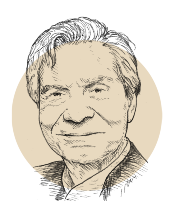One is burgundy, emblazoned with the golden French coat of arms and the republican fasces which serves as a symbol of the Revolution of 1789. The other is navy blue, adorned with the American eagle. Both passports are mine, and are a testament to my dual citizenship and my shared happiness. We are so used to these official documents that we rarely look at them closely. Yet we should, as certain details are quite significant.
The French passport is not just French. The title “Union européenne” is written on the top of the cover, making its owner more than a mere French citizen. Holders of a French passport are members of a far more ambitious political project to change from a nation to Europe, to ensure our continent will never again be torn apart by war. Europe has survived despite occasional bickering, and new members (from the former Yugoslavia, among others) are keen to join. The burgundy was only used for the cover following years of negotiations which finally resulted in an unanimous decision from the member governments. The use of the same color for all passports in the new Union accelerated the theoretical dissolution of borders between France and its neighbors. It is not so long ago that travelling from Paris to Brussels or Madrid required two different customs checks. Let us hope the recent fear of terrorist infiltration does not force us backwards in our development. While flicking through my passport I was astonished to see that only the regions of France were represented. It seems the front cover is European, but the inside pages are French. Perhaps this is an allegory for French national ambivalence towards the Union? Either way, a little more enthusiasm would be appreciated.
The American passport, or more precisely from the United States of America, is also filled with surprises. Those responsible for the original designs of the inside pages seem to be unhappy with our time. The illustrations conjure up images of a forgotten country: a field of corn worked by harnessed cattle, a paddle steamer sailing down the Mississippi, cowboys rounding up their longhorn herds, a steam train traveling across the plains, a Native American totem pole, and a whaling sailboat are just a few. Even the national monuments displayed are hardly recent, such as Independence Hall in Philadelphia and the Statue of Liberty. The only modern icon is a satellite on the last page. If anyone were to try to understand our countries by looking through these passports and observing the symbolic representations of what we claim to be, they would assume that France is a collection of old provinces and that the United States is a nation supported by agriculture and livestock. I fail to see the advantage of such nostalgia. It may be that looking back into the past is a way of avoiding any controversy with regard to our current national identities.
My goal is not to describe my two passports, but rather to combine them for practical reasons. As a dual citizen I am aware that I will enjoy for the first time the rare yet legal privilege of voting twice for my respective presidents within the space of several months. This phenomenon is curious, although significant, as my dual citizenship also means I have to declare my taxes twice and submit to the procedural whims of two administrations. Both are inquisitorial, but there seems to be a greater respect for the law in American administrations. That being said, I am neither Afro-American nor Franco-Arabic, and so my impressions and experience may not be objective.
These two simultaneous elections will offer the citizens of both countries a choice between seemingly similar options. Will they predictably vote for the partisans of reason, or instead for the partisans of risk whose politics is generally qualified as “populism” by both countries? We use the term populism, as the Tea Party, the Vermont Socialists and the Front National are not so much left-wing or right-wing as elsewhere altogether, stirring up rebellions against the smoothed-over, formatted “elite.” The “nominees” are so far unknown in France and America. I wonder, will we be given the choice between candidates who are either too polite or too vindictive? As an Independent, I will have to wait and see.
Despite their similar official appearances, the French and American presidents have little in common. President Hollande is a republican monarch, and is one royal crown away from being as capricious as Louis XIV. The Pilgrim Fathers would be pleased to see that the American president has remained a Gulliver character, chained up by countless counter-powers wielded by the States, Congress and the justice system. But in times of war, the American president becomes the leader of France; while the French army is formidable on a European scale, it falls terribly short on a global battleground. There is no major conflict in which the French president may act without American approval, however this hierarchy only goes one way.
I will therefore vote for my two presidents, choosing the French candidate in times of peace and the American candidate – God forbid – in times of war. Former French ambassador in Washington, Jean-David Levitte, once said that all Europeans should have the right to vote for a handful of American senators as they have a considerable influence over Europe. I will take this into consideration when voting for both my presidents and my state senators. I am sure I will find someone sensible.












